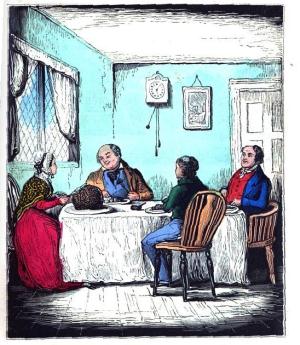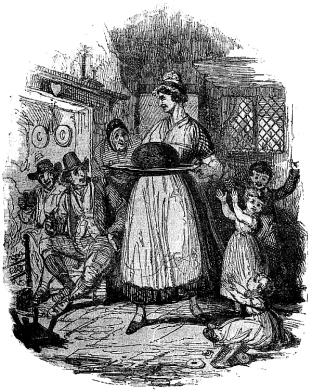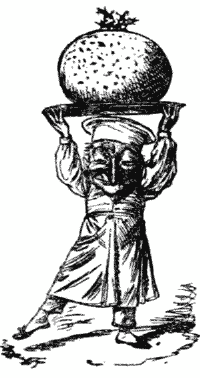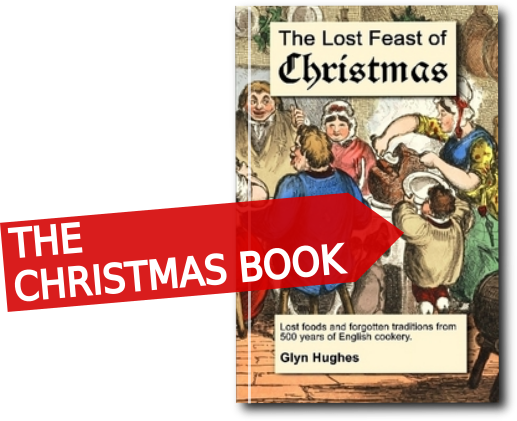

|
 Image: BBC A steamed pudding, very heavy in dried and other fruit and suet and bound with either or both of breadcrumbs and flour, made very dark, almost black, by the addition of black treacle or Muscavado sugar and dark beer such as stout. Christmas puddings were formerly boiled in a pudding cloth, giving the iconic spherical shape, but are now more commonly formed in a rounded basin. Christmas pudding is most traditionally brought to the festive table whole, topped with a sprig of holly and flamed with brandy. Served with sweet white sauce, brandy butter, cream, custard and/or sprinkled with sugar. Although rich fruit puddings are known from the earliest times, they were not specifically associated with the Christmas feast. The poet Thomas Tusser (born 1515) does refer to a pudding at christmas, but that is “Brawn pudding and souse, and good mustard withal.” The ‘Bill of Fare for Christmas Day’ in Robert May 1660 includes a great deal of roast meat and mince pies, but no pudding. In the time of Bradley 1728 we get a receipt for ‘Plum-Pottage, or Christmas-Pottage’ – a stew of beef stock with with wine, beer, cloves, mace, nutmeg, currants, apple and raisins.  Original Receipt in ‘The Country Housewife and Lady’s Director‘ by Prof. R Bradley, 1728 (Bradley 1728) Original Receipt in ‘The Country Housewife and Lady’s Director‘ by Prof. R Bradley, 1728 (Bradley 1728)Plum-Pottage, or Christmas-Pottage. Take a Leg of Beef, and boil it till it is tender in a sufficient quantity of Water, add two Quarts of red Wine, and two Quarts of old strong Beer; put to these some Cloves, Mace, and Nutmegs, enough to season it, and boil some Apples, pared and freed from the Cores into it, and boil them tender, and break them; and to every Quart of Liquor, put half a Pound of Currans pick’d clean, and rubb’d with a coarse Cloth, without washing. Then add a Pound of Raisins of the Sun, to a Gallon of Liquor, and half a Pound of Prunes. Take out the Beef, and the Broth or Pottage will be fit for use.  2014 While there are references to Christmas Puddings in the 18th Century – the earliest we can find is in the ‘The Gentleman’s Magazine‘ of 1790 – the first actual receipt seems to be;  Original Receipt from ‘Modern Domesic Cookery‘ by Elizabeth Hammond (Hammond 1819) Original Receipt from ‘Modern Domesic Cookery‘ by Elizabeth Hammond (Hammond 1819)Boiled plum or Christmas pudding. Cut a pound of beef-suet extremely fine, to which add a pound of raisins well stoned, half a pound of currants, picked, cleaned, and dried, some nutmeg, two spoonsful of brandy, two ounces of candied lemon-peel, and one ounce of candied orange-peel shred fine, six well beaten eggs, a gill of cream, and seven or eight table-spoonsful of flour, mix them well, and boil it four hours; when done, serve with melted butter and grated sugar. Stir-up Sunday  Original Receipt from ‘A Shilling Cookery for The People‘ by Alexis Soyer (Soyer 1845) Original Receipt from ‘A Shilling Cookery for The People‘ by Alexis Soyer (Soyer 1845)334. Plum Pudding. – Pick and stone half a pound of Malaga raisins, wash and dry the same quantity of currants, chop, not too fine, three-quarters of a pound of beef suet, put it in a convenient basin, with six ounces of sugar, two ounces of mixed candied peel sliced, three ounces of flour, three ditto of bread-crumbs, a little grated nutmeg, four eggs, a gill of water, or perhaps a little more, to form a nice consistence; butter a mould, put a piece of white paper over the top and round the gides, tie it in a cloth, boil for four hours in plenty of water; when done, remove the cloth, turn it out of the mould, take the paper off the sides and top, and serve with sweet sauce round; it may also be boiled in a cloth. The above is only for Christmas.  Original Receipt in ‘The Book of Household Management‘ edited by Isabella Beeton, 1861 (See Mrs.B) Original Receipt in ‘The Book of Household Management‘ edited by Isabella Beeton, 1861 (See Mrs.B)A PLAIN CHRISTMAS PUDDING FOR CHILDREN. 1327. INGREDIENTS. – 1 lb. of flour, 1 lb. of bread crumbs, ¾ lb. of stoned raisins, ¾ lb. of currants, ¾ lb. of suet, 3 or 4 eggs, milk, 2 oz. of ;candied peel, 1 teaspoonful of powdered allspice,1/2 saltspoonful of salt. Mode. – Let the suet be finely chopped, the raisins stoned, and the currants well washed, picked, and dried. Mix these with the other dry ingredients, and stir all well together; beat and strain the eggs to the pudding, stir these in, and add just sufficient milk to make it mix properly. Tie it up in a well-floured cloth, put it into boiling water, and boil for at least 5 hours. Serve with a sprig of holly placed in the middle of the pudding, and a little pounded sugar sprinkled over it. Time. – 5 hours. Average cost, 1s. 9d. Sufficient for 9 or 10 children. Seasonable at Christmas. RAISINS. – Raisins are grapes, prepared by suffering them to remain on the vine until they are perfectly ripe, and then drying them in the sun or by the heat of an oven. The sun-dried grapes are sweet, the oven-dried of an acid flavour. The common way of drying grapes for raisins is to tie two or three bunches of them together, whilst yet on the vine, and dip them into a hot lixivium of wood-ashes mixed with a little of the oil of olives: this disposes them to shrink and wrinkle, after which they are left on the vine three or four days, separated, on sticks in a horizontal situation, and then dried in the sun at leisure, after being cut from the tree. CHRISTMAS PLUM-PUDDING. (Very Good.) 1328. INGREDIENTS. – 1-1/2 lb. of raisins,1/2 lb. of currants, 1/2 lb. of mixed peel, ¾ lb. of bread crumbs, ¾ lb. of suet, 8 eggs, 1 wineglassful of brandy. Mode. – Stone and cut the raisins in halves, but do not chop them; wash, pick, and dry the currants, and mince the suet finely; cut the candied peel into thin slices, and grate down the bread into fine crumbs. When all these dry ingredients are prepared, mix them well together; then moisten the mixture with the eggs, which should be well beaten, and the brandy; stir well, that everything may be very thoroughly blended, and press the pudding into a buttered mould; tie it down tightly with a floured cloth, and boil for 5 or 6 hours. It may be boiled in a cloth without a mould, and will require the same time allowed for cooking. As Christmas puddings are usually made a few days before they are required for table, when the pudding is taken out of the pot, hang it up immediately, and put a plate or saucer underneath to catch the water that may drain from it. The day it is to be eaten, plunge it into boiling water, and keep it boiling for at least 2 hours; then turn it out of the mould, and serve with brandy-sauce. On Christmas-day a sprig of holly is usually placed in the middle of the pudding, and about a wineglassful of brandy poured round it, which, at the moment of serving, is lighted, and the pudding thus brought to table encircled in flame. Time. – 5 or 6 hours the first time of boiling; 2 hours the day it is to be served. Average cost, 4s. Sufficient for a quart mould for 7 or 8 persons. Seasonable on the 25th of December, and on various festive occasions till March. Note. – Five or six of these puddings should be made at one time, as they will keep good for many weeks, and in cases where unexpected guests arrive, will be found an acceptable, and, as it only requires warming through, a quickly-prepared dish. Moulds of every shape and size are manufactured for these puddings, and may be purchased of Messrs. R. & J. Slack, 336, Strand.  Cutting the Christmas Pudding, Hand-coloured print from Aunt Affable’s Stories, about 1830 During the 1920s, led by the ‘British Women’s Patriotic League’s “Empire Shopping Week”, advertising for the Empire Christmas Pudding urged housewives to help in “giving employment to your own kith and kin” by supporting Empire produce. Making the Empire Christmas Pudding. Artwork by F C Harrison for the Empire Marketing Board, via australianfoodtimeline.com.au The Church collect for the Sunday five weeks before Christmas begins “Stir up, we beseech thee, O Lord, the wills of thy faithful people; that they, plenteously bringing forth the fruit of good works”. This gave it the name of ‘Stir-Up Sunday’, the day on which the mixture for Christmas pudding is prepared, with each member of the household taking a lucky share in the mixing. This style of Pudding is sometimes, mysteriously, called by the name of other puddings, ‘Plum Duff‘ or ‘Figgy Pudding‘. We can’t find any traditional Christmas Pudding receipt that calls for plums, nor one with figs. It is almost certain that ‘plum’ refers to its colour and shape, and it is known that ‘figgy’ means ‘having an appearance like the inside of a fig’, ie, filled with fruity specks, which might be any dried fruit. Many households consider that five weeks is far too short a time for the pudding to properly mature, making it the preceding Easter, or even one year ahead, often ‘feeding’ it weekly with brandy or whisky.  From ‘Christmas: Its Origin and Associations’, by William Francis Dawson It has been common to include small tokens or silver coins in the mixture, to be kept as a gift by finder. I’ve never been able to find out how or where this custom originates, but one myth about it can be definitively destroyed. That’s the story, put about by such illuminated sources of wisdom as The Daily Telegraph (18 Oct 2005), that the practice of putting coins in puddings has somehow been banned on account of ‘health and safety’. So pernicious is this rumour that the UK Health and Safety Executive has found it necessary to issue an official rebuttal; Finding a coin in your pudding on Christmas day – it’s a tradition that’s lasted for more than 500 years and is said to grant you a good luck wish for the coming year. However, killjoys have been stirring up trouble saying it’s too risky to put coins inside puddings for ‘health and safety’ reasons. Occupational health and safety law is concerned with what goes on in your workplace, not what you’re eating after a Turkey dinner – it doesn’t prevent coins or any other lucky charms being put in puddings. If we had one wish, it would be to stamp out the health and safety Scrooges who try to dampen the Christmas spirit. Sir JJ Thomson’s discovery of the structure of atoms as being spheres dotted with electrons is often called, though not by Thompson himself, the ‘Plum Pudding Model’ of atomic structure. Almost all bought Christmas Puddings in the UK and Ireland are manufactured by one company – Matthew Walker of Heanor in Derbyshire, who produce some 20 million puddings each year.  Mr. Punch brings in the Pudding (From ‘Punch’ magazine)   |
|
MORE FROM Foods of England... Cookbooks ● Diary ● Index ● Magic Menu ● Random ● Really English? ● Timeline ● Donate ● Royalty ● English Service ● Food Map of England ● Lost Foods ● Accompaniments ● Biscuits ● Breads ● Cakes and Scones ● Cheeses ● Classic Meals ● Curry Dishes ● Dairy ● Drinks ● Egg Dishes ● Fish ● Fruit ● Fruits & Vegetables ● Game & Offal ● Meat & Meat Dishes ● Pastries and Pies ● Pot Meals ● Poultry ● Preserves & Jams ● Puddings & Sweets ● Sauces and Spicery ● Sausages ● Scones ● Soups ● Sweets and Toffee ● About ... ● Bookshop ● Email: [email protected] COPYRIGHT and ALL RIGHTS RESERVED: © Glyn Hughes 2022 BUILT WITH WHIMBERRY |